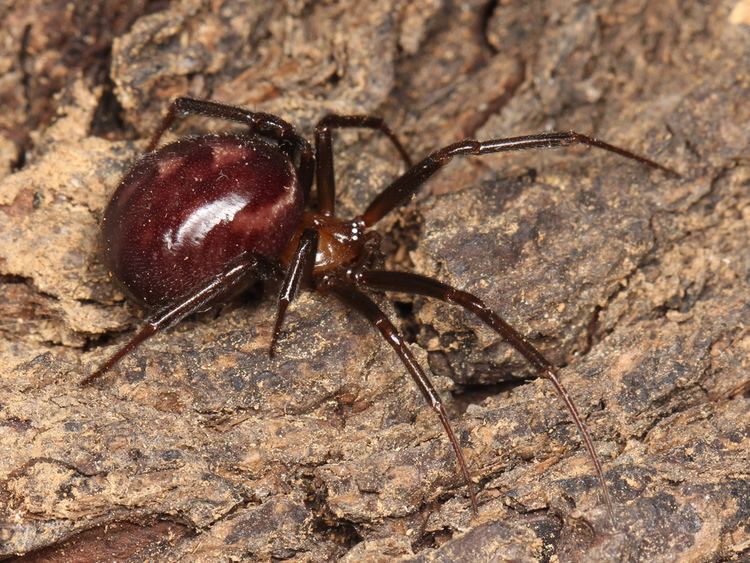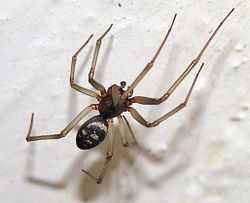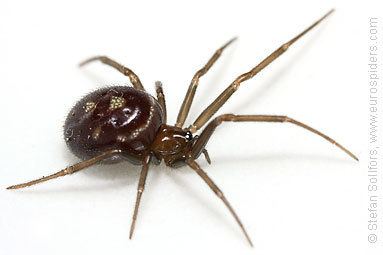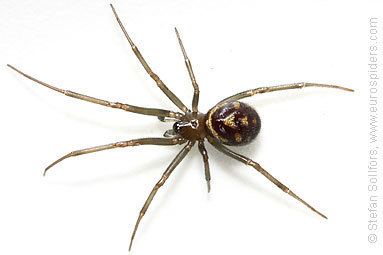Rank Species | Higher classification False black widows Order Spider | |
 | ||
Similar False black widows, Theridiidae, Noble false widow, Triangulate cobweb spider, Steatoda bipunctata | ||
Feeding a false widow spider steatoda grossa in hd 1080p
Steatoda grossa, commonly known as the cupboard spider, the dark comb-footed spider, the brown house spider (in Australia), or the false black widow (though several other species are known by these names), is a common species of spider in the genus Steatoda.
Contents
- Feeding a false widow spider steatoda grossa in hd 1080p
- False black widow cupboard spider steatoda grossa
- Description
- Habitat and range
- Medical significance
- In popular culture
- References

It is a cosmopolitan species found in many parts of the world, including North America, Australasia, and Europe. As one of this spider's common names indicates, the spider superficially resembles, and is frequently confused for, the black widow and other venomous spiders in the genus Latrodectus.

False black widow cupboard spider steatoda grossa
Description

Like black widows, the female S. grossa is 6-10.5 mm in length and dark colored with a round, bulbous abdomen. Typical coloration ranges from purplish brown to black, with light-colored markings. Unlike black widows, redbacks, and other Latrodectus species, S. grossa does not have a bright red hourglass pattern or any other bright markings. Like many spiders, the male is sometimes smaller but can many times be nearly as long as the females. It measures 4.1-10.0 mm in length and is thinner than the female. The two sexes are colored similarly; however, the sexually mature male almost always has lighter, more reddish-coloured legs than the female. S. grossa spiders may shed up to six times (instars) before reaching maturity. They can go several months without feeding, provided they have access to water. A well-fed female can lay three or more egg sacs each year. Each egg sac typically contains between 40-100 eggs. The mother can often be observed watching her eggs for hours, even days, at a time once the eggs start changing color and grow close to hatching. At normal household temp/humidity, an egg will usually hatch within a month of being laid. The spiderlings are independent from time of hatch.

Female S. grossa spiders can live up to six years; the typical lifespan for the male is 1-1.5 years. Males often die shortly after mating.
Habitat and range
As is common with other members of the family Theridiidae, S. grossa constructs a cobweb, i.e., an irregular tangle of sticky silken fibers. As with other web weavers, these spiders have very poor eyesight and depend mostly on vibrations reaching them through their webs to orient themselves to prey or warn them of larger animals that could pose a danger. They are not aggressive, and most injuries to humans are due to defensive bites delivered when a spider gets unintentionally squeezed or pinched. It is possible that some bites may result when a spider mistakes a finger thrust into its web for its normal prey, but ordinarily intrusion by any large creature will cause these spiders to flee.
S. grossa is a cosmopolitan species and is found in many parts of the world, including all three coasts in North America, in Australia and New Zealand, and in Europe.
A related species, commonly found in North America, is Steatoda borealis. This spider is similar to S. grossa in shape, but slightly smaller, and is generally found in colder climates. This spider can be identified by colored markings on the dorsal side of its abdomen rather than on the ventral side.
Medical significance
The bite of S. grossa is known to be medically significant in humans, but minor, without any long-lasting effects. Symptoms of bites include blistering at the site of the bite, muscle spasms, pain, fever, sweating, and/or a general malaise lasting for several days. Latrodectus antivenom was shown to be effective in treating bites from Steatoda grossa after it was mistakenly administered to a S. grossa bite victim who was erroneously believed to have been bitten by the far more dangerous redback.
In popular culture
A specimen of S. grossa (painted with nontoxic blue and red stripes and "wrangled" by Steven R. Kutcher ("The Spider-Man Behind Spider-Man") was used as the spider which bit Peter Parker in the Sam Raimi-directed Spider-Man film released in 2002.
